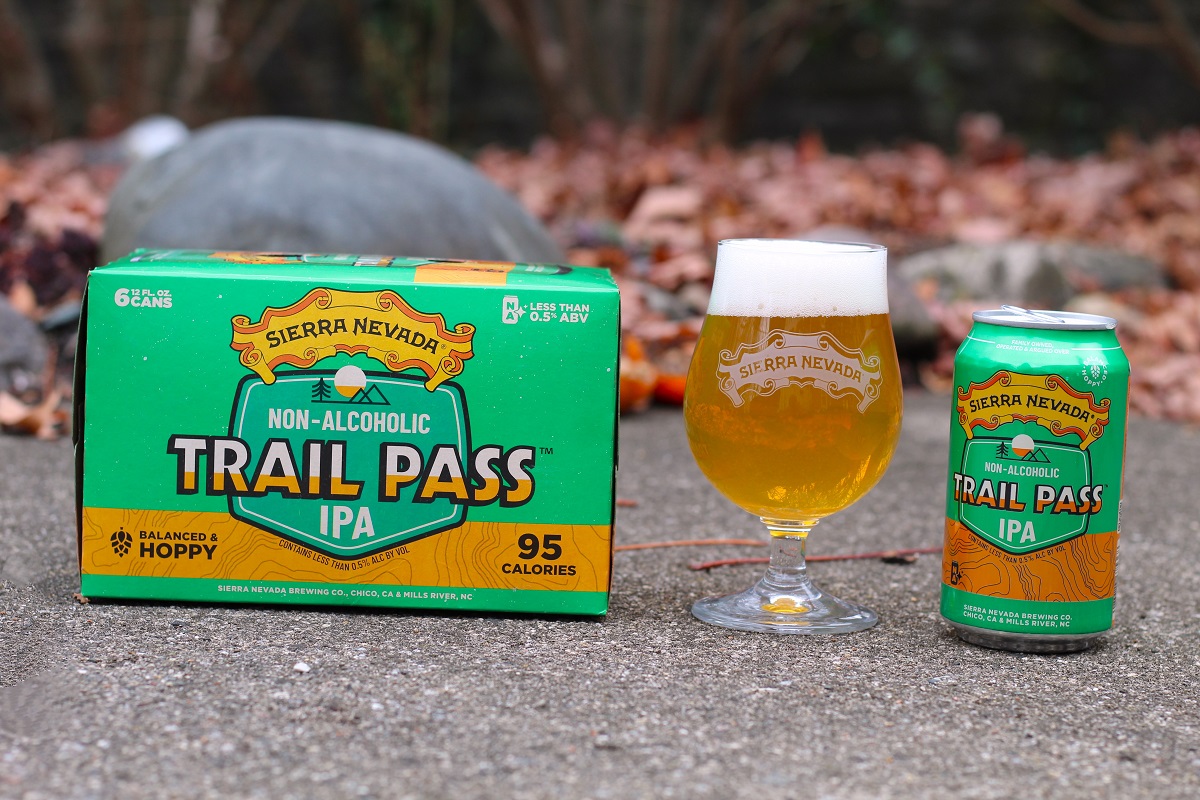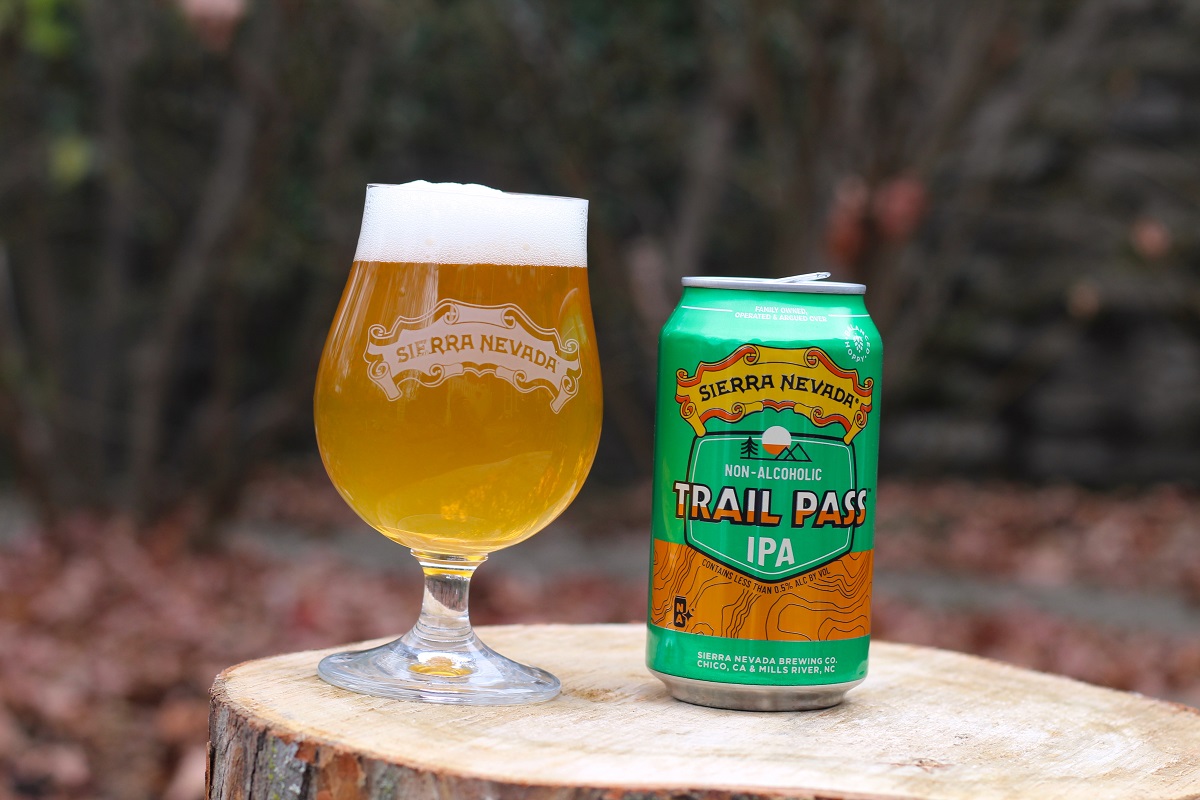Sierra Nevada Brewing Company is entering the growing non-alcoholic (NA) beer space with their new Trail Pass series, which hits shelves this month with two initial beers: Golden and IPA. The iconic brewery known for standard alcoholic brands like Pale Ale, Celebration Ale, and Hazy Little Thing debuted their new NA offerings at Denver’s Great American Beer Festival in September, and expects the beers to hit shelves across their full distribution footprint by the beginning of January.
While non-alcoholic beers are one of the few segments of craft beer seeing strong growth, the development of the NA line wasn’t a reactionary or opportunistic decision for the Chico, California-based brewery. The Trail Pass beers have been in development for a full five years.
James Conery, Sierra Nevada’s Innovation Brewmaster, says the early hang-ups that delayed the project revolved around a simple problem that often hampers nascent industries: science had not yet caught up with ambition. At the time, the leading method of non-alcoholic beer production involved brewing standard-strength beers and then removing alcohol through vacuum distillation (these are still popular methods for producing NA beer). Conery and his team felt this process damaged a beer’s flavors, and wanted to look for a gentler method of production.

“The reason it took so long was because the science and ingredients and practices that were out there at that time didn’t meet our quality criteria and our threshold for consistency,” he explains.
Sierra Nevada wanted to create a non-alcoholic beer through creative use of yeast, malt selection, and brewhouse practices rather than through distillation or filtration, and fortunately, the right yeast finally came along. They were able to get involved in a trial from Canadian yeast lab Lallemand for a maltose-negative Saccharomyces cerevisiae strain that could be used for producing low or no alcohol beers.
Saccharomyces cerevisiae is the species of yeast used to ferment ale styles. Lallemand used a wine strain of S. cerevisiae to breed a new strain that does not ferment maltose, preventing the strain from being able to convert the primary sugar in wort into ethanol. It also produces very little sulfur, and metabolizes malt aldehydes, which can contribute to flavor degradation in packaged beer.
Lallemand’s Lalbrew® LoNa™ was created entirely through conventional breeding practices, and is not genetically-modified.
“The science behind yeast breeding finally caught up with the craft world,” Conery explains, saying once the yeast problem was figured out, the remainder of the development process for Trail Pass was fairly linear and came down to fine-tuning. “The thing we were very excited about was being able to follow our standard process and get a 7-8 day fermentation time. It’s very standard from a brewing perspective.”
Like many non-alcoholic brewers, Conery is cagey on some of the behind-the-scenes details of brewing the Trail Pass series, and was not able to provide specifics of the beers’ malt recipes. He does highlight that the grain bills for these beers are very similar to what would be used in standard strength versions of each style.
“We do spend a little more time in the brewhouse adjusting some temperatures to drive off aromas and compounds that are going to contribute those worty characteristics,” he says, referring to the unfermented wort flavors that dog many NA beers. “The yeast does a lot of the heavy lifting on the back end. Once we knew what we wanted, it was just a matter of being brewers and picking a grain bill for an IPA or a Golden Ale. It was pretty straightforward.”
Hops Behaving Differently
With the non-alcoholic process ironed out, Sierra Nevada had to figure out what to do with another of beer’s foundational ingredients: hops. While it might seem like hop practices wouldn’t need to change for NA beers, the presence of alcohol does play a role in how hop characteristics are presented. Since Sierra Nevada is a brewery that has built much of its reputation on hop-forward beers, they needed to get this right. After all, the Trail Pass beers didn’t just need to taste good; they needed to taste like Sierra Nevada.
“We basically took every hop we have in our inventory and made small test batches with each,” says Conery. Sierra Nevada used 6 two-barrel fermenters to split batches and hop them separately, and Conery says they were all full for months on end. The brewery was developing a non-alcoholic hop water called Hop Splash at the time, and they took a lot of the lessons learned from that project and applied them to the Trail Pass beers.

“Hop Splash led us to develop a new methodology for dry hopping non-alcoholic products,” he explains. The team found that not every hop adapted well to the process. Citra and Amarillo performed well and ultimately were the choice for Trail Pass IPA, whereas Mosaic wasn’t as impactful as expected.
“When you lose alcohol as a solvent, it changes the profile of what your dry hopping does,” he explains. “Then especially if you don’t have fermentation for the biotransformation components and liberation of aroma compounds, it proved to be very difficult.”
What’s the Occasion?
That all answers How the Trail Pass were developed, but why did one of the country’s largest craft brewers spend half a decade developing a non-alcoholic beer, a process that began before the segment had really established itself as a growth market? Brand Director Kyle Ingram says the brewery wasn’t focused just on folks who have given up alcohol.
“I think it’s more about where consumer trends are going, not necessarily going from drinking to total abstinence, but somewhere in-between,” he explains, highlighting a segment of craft drinkers who haven’t given up alcohol entirely, but are adjusting their consumption levels. “In that moderation lifestyle, we want to have solutions for all those occasions.”
The word occasions might smack of marketing-speak, but it’s clearly front-of-mind for Ingram, and he repeatedly. As craft beer sales flatten and even dip, breweries of all sizes can’t just shove more of the same beer at the same audience and hope for the best. As the needs of that audience change, the brewery has to change with it. Ingram acknowledges that while the NA segment is seeing rapid growth internally, it still represents less than 1 percent of total craft beer volume. He says that while he believes it’s realistic for NA to eventually approach 10% of craft, Sierra Nevada’s current focus is upon finding the customers and moments for their NA beers and growing into them.
He also highlights the appeal of an NA option for the brewery’s many employees when a standard-strength shift beer might not be the best idea.
“Safety is really important to us, and there are moments when a beer is not appropriate.”
Keep Scrolling
So far, test audiences have responded positively to the Trail Pass beers, with enthusiasm split roughly 50-50 between the IPA and Golden.
While NA beers have often been marketed for an active audience, Ingram thinks it’s important to position NA options as more standard options for everyday situations.
“There are those moments when I’m relaxing on a weekday after work, and I just need to kind of tune out, or I’m in a social situation,” he explains. “I don’t think that is talked about enough. It’s the sociability aspect because there has traditionally been a stigma around NA beer and consumers didn’t really want to signal they were drinking it because people might infer something about them. You can hold a Trail Pass at a party and it’s going to signal Sierra Nevada, and the non-alcoholic part is sort of secondary to that.”

Brand recognition is very important to a brewery of Sierra Nevada’s size, and they wanted the Trail Pass beers to be easy to identify as their own, while still distinguishing them from their standard beers.
“That conversation starts with The Scroll, right?” Ingram says. The iconic golden scrollwork that sits behind the brewery’s name on labels of legacy brands like Pale Ale, Celebration, and Bigfoot is prominent on Trail Pass cans. The brewery hopes that newcomers to NA who might not know where to look will see the scroll on cans and trust Sierra Nevada knows what they’re doing with what’s inside. As for the name Trail Pass, the brewery is aware of its outdoorsy image for many drinkers, and they wanted to tie in with that while also signaling something deeper.
“If you’re on non-alcoholic journey, whatever that looks like for you, we want to have something for your journey, something that can help you get to wherever you want to go with that.”
While the brewery isn’t letting the cat out of the bag on future releases, both Conery and Ingram hinted to expect more styles to be added to the Trail Pass line-up later in 2024 and beyond.
Cover image courtesy of Sierra Nevada Brewing Company. All other photos by David Nilsen.














